A text dump on the UK governments response to leftist movements
Introduction to Counter-Terrorism
Northern Ireland-related terrorism
Counter Terrorism Policing \ What We Do \ Prevent
Mixed, unclear or unstable cases
Concerns that a child or young person is being radicalised online
How children, young people and adult learners become vulnerable to radicalisation
ProtectUK - The Threat from Left-Wing, Anarchist and Single-Issue Terrorism (LASIT)
What is LASIT and what ideologies does it include?
What LASIT attacks have taken place in the West?
How does LASIT manifest in the UK?
Probability and Likelihood in Intelligence Assessments
Education against Hate - Let’s Discuss: Extreme Left-Wing, Anarchist and Single-Issue Extremism
Examples of extreme left-wing, anarchist and single-issue terrorism
Where to find out more information
Far-left extremism: then and now
MI5 Counter-Terrorism
https://www.mi5.gov.uk/counter-terrorism
Home > What we do > Counter-Terrorism
Introduction to Counter-Terrorism
What is terrorism?
Terrorist groups use violence and threats of violence to publicise their causes and as a means to achieve their goals. They often aim to influence or exert pressure on governments and government policies but reject democratic processes, or even democracy itself.
International terrorism
International terrorism from groups such as the Islamic State in Iraq and the Levant (ISIL) and Al Qaeda present a threat from many others. They hold territory in places without functioning governments, making it easier for them to train recruits and plan complex, sophisticated attacks. Drawing on extreme interpretations of Islam to justify their actions, these groups often have the desire and capability to direct terrorist attacks against the West, and to inspire those already living there to carry out attacks of their own.
Northern Ireland-related terrorism
Northern Ireland-related terrorism continues to pose a serious threat to British interests. Although the Provisional Irish Republican Army (PIRA) has ceased its terrorist campaign and is now committed to the political process, some dissident republican groups continue to mount terrorist attacks, primarily against the security forces.
RWT/LASIT terrorism
MI5 took primacy for Right Wing Terrorism (RWT) and Left, Anarchist and Single-Issue Terrorism (LASIT) in April 2020. All terrorist threats arising from these ideologies are managed in the same way as our International Terrorism casework.
Countering terrorism
MI5 has countered terrorist threats to UK interests, both at home and overseas, since the 1960s and the threat has developed significantly since then. It's challenging to understand the intentions and activities of secretive and sometimes highly organised groups. New and changing technologies make it increasingly difficult to obtain information necessary to disrupt the attack planning of these groups. Many are based in inaccessible areas overseas and there are limits to what can be done to prevent attacks planned and launched from abroad. Our techniques and the way we with work with other agencies both at home and abroad have to keep pace with the terrorists' capabilities.
Counter Terrorism Policing \ What We Do \ Prevent
https://www.counterterrorism.police.uk/what-we-do/prevent/
We prevent vulnerable people from being drawn into extremism
Police have a long history of working to prevent vulnerable people being drawn into criminal behaviour. The government-led, multi-agency Prevent programme aims to stop individuals becoming terrorists and police play a key role.
We work with local authority partners and community organisations to help find solutions and work to support and protect vulnerable people.
Following assessment, many referrals to Prevent do not result in any further police action. In some cases other organisations such as health, forensic mental health, housing or education step in to provide support.
All referrals to police are handled with sensitivity and in confidence. If a person is assessed as being a terrorism risk, they may be referred to Home Office’s Channel Programme and maybe given help from a mentor.
UK Policing has a proud history of community engagement, and the success of Counter Terrorism Policing – just like other areas of policing – relies on the trust, confidence and support of all communities.
The Counter Terrorism Advisory Network (CTAN) is a national stakeholder engagement forum, which was formed by Counter Terrorism Policing in 2017. It is independently chaired, and its membership consists of survivors of terrorism, academics and researchers, a variety of faith leaders, and members who reach others through community organisations and groups – all of which are independent of policing.
Counter Terrorism Policing created the CTAN in order to speak directly and indirectly to those affected by terrorism, so they can be a ‘critical friend’ to policing and provide feedback on a variety of issues linked to Counter Terrorism strategy and policy. Consultation events and the contributions of members help to better understand the potential impact of policing activities and policies, and where necessary, to make changes to Counter Terrorism Policing’s approach.
Department for Education - Understanding and identifying radicalisation risk in your education setting
Published 24 October 2022
Applies to England
Contents
3. Mixed, unclear or unstable cases
5. How children, young people and adult learners become vulnerable to radicalisation
6. Risk factors
Print this page
To safeguard children, young people and adult learners who are vulnerable to radicalisation, designated safeguarding leads (DSLs) will need to take a risk-based approach.
The DSL should understand the risk of radicalisation in their area and educational setting. This risk will vary greatly and can change quickly, but nowhere is risk free.
To understand the risks or threats in your area, contact your:
-
Prevent coordinator or Prevent education officer in your local authority (if applicable)
-
HEFE regional Prevent coordinator (if you have one)
-
local policing team
-
local authority or safeguarding children partnership
-
local authority or police Prevent partners (for access to your counter-terrorism local profile)
The threat of terrorism
The Terrorism Act 2006 defines ‘terrorism’ as an action or threat designed to influence the government or intimidate the public. Its purpose is to advance a political, religious or ideological cause.
In summary, terrorism is an action that:
-
endangers or causes serious violence to a person or people
-
causes serious damage to property, or seriously interferes with or disrupts an electronic system
-
is designed to influence the government or to intimidate the public
The Prevent duty provides a framework for specified authorities to respond to the changing nature of threat in the UK. The government’s counter-terrorism (CONTEST) strategy 2018 says the main threat to the UK comes from Daesh or Al Qa’ida inspired terrorism, although extreme right wing terrorism is a growing threat.
Some groups and organisations are proscribed. This means they’re banned under counter-terrorism measures introduced under the Terrorism Act 2000 (for example, Daesh and National Action).
The Home Office has published a list of proscribed terrorist groups or organisations.
The extremism threat
The counter-terrorism (CONTEST) strategy 2018 defines ‘extremism’ as vocal or active opposition to the fundamental British values of:
-
democracy
-
the rule of law
-
individual liberty
-
mutual respect
-
tolerance of people with different faiths and beliefs
Extremism also includes calls for the death of members of the armed forces, whether in this country or overseas. Some groups and organisations that promote extremist ideologies are not proscribed terrorist groups or organisations.
These groups support divisive or hateful narratives towards others, but may not promote extreme violence. For example, they may hold views that support the distrust or hatred of people with different faiths or undermine the principles of democracy.
We have published resources to help explain:
Mixed, unclear or unstable cases
Some children, young people and adult learners may appear engaged with, or have adopted, a mixed, unclear or unstable ideology that supports extreme violence.
Mixed, unclear or unstable cases could include individuals who:
-
show an interest in multiple extremist ideologies at the same time
-
switch from one ideology to another over time
-
target a ‘perceived other’ of some kind (perhaps based on gender or another protected characteristic), but do not otherwise identify with one particular terrorist ideology or cause - for example, involuntary celibates (incels) who direct their anger mainly at women
-
are obsessed with massacre, or extreme or mass violence, without specifically targeting a particular group - for example, high school shootings
-
may be vulnerable to being drawn into terrorism out of a sense of duty, or a desire for belonging, rather than out of any strongly held beliefs
Online radicalisation
Children, young people and adult learners are at risk of accessing inappropriate and harmful extremist content online. This could include downloading or sharing terrorist material, which could be a criminal act.
The internet and social media make spreading divisive and hateful narratives to millions of people easy. Extremist and terrorist groups and organisations use social media (for example, apps, forums, blogs, chat rooms) to identify and target vulnerable individuals.
You do not need to be an online expert to understand when a child, young person or adult learner is at risk of harm. You should deal with harmful online behaviour in the same way as offline activity.
Concerns that a child or young person is being radicalised online
Any child, young person or adult learner who uses the internet can be at risk of online abuse.
Education settings need to be aware of the risks and talk to children, young people and adult learners about staying safe online.
If you’re concerned that a child, young person or adult learner is vulnerable to radicalisation online, you should follow your normal safeguarding procedures.
Radicalisation is like grooming. Whether this happens online or offline, you should treat it in the same way.
How children, young people and adult learners become vulnerable to radicalisation
There’s no single way of identifying whether a child, young person or adult learner is likely to be susceptible to an extremist ideology or vulnerable to radicalisation.
The process of radicalisation is different for every individual. It can take place over a long period, or it can be very quick.
Children, young people and adult learners who are vulnerable to grooming for sexual exploitation, criminal exploitation or county lines, may also be vulnerable to radicalisation. Factors could include things like being a victim or witness of crime, abuse or bullying, or having personal or emotional difficulties.
Adverse childhood experiences, combined with specific influences from family and peers or online connections, may make someone more vulnerable to radicalisation.
Extremist influences could include, but are not limited to:
-
family members having direct contact or involvement with extremist or terrorist groups
-
staff members of an education or community setting promoting an extremist ideology
-
peers promoting an extremist ideology or sharing extremist material
-
access or exposure to online extremist material via social media or the internet - for example, propaganda including pictures, videos, blogs and fake news
-
exposure to extremist, terrorist or other violent activity in overseas settings
-
access or exposure to extremist leaflets, magazines or stickering
-
exposure to extremist groups hosting marches, protests or stalls
Risk factors
Push and pull factors can make a child, young person or adult learner at risk of extremism or radicalisation. Often there are several risk factors present that, seen together, can cause concern.
Push factors
Push factors may include a child, young person or adult learner feeling:
-
isolated
-
they do not belong
-
they have no purpose
-
low self-esteem
-
their aspirations are unmet
-
anger or frustration
-
a sense of injustice
-
confused about life or the world
-
real or perceived personal grievances
Pull factors
Pull factors could include an extremist or terrorist group, organisation or individual:
-
offering a sense of community and a support network
-
promising fulfilment or excitement
-
making the child, young person or adult learner feel special and part of a wider mission
-
offering a very narrow, manipulated version of an identity that often supports stereotypical gender norms
-
offering inaccurate answers or falsehoods to grievances
-
encouraging conspiracy theories
-
promoting an ‘us vs. them’ mentality
-
blaming specific communities for grievances
-
encouraging the use of hatred and violent actions to get justice
-
encouraging ideas of supremacy
ProtectUK - The Threat from Left-Wing, Anarchist and Single-Issue Terrorism (LASIT)
11/11/2022
We look at the threat that organisations and individuals face from LASIT
What is LASIT?
Left-Wing, Anarchist and Single-Issue Terrorism (LASIT) encompasses a wide range of ideologies. It includes those from the political left-wing as well as anarchists who seek to use violence to advance their cause in opposition to the capitalist system. It also includes those with single-issue grievances who seek to use violence in opposition to a specific policy or practice.
Headline Assessment
-
We assess a terrorist attack in the UK motivated by LASIT ideology to be highly unlikely. The threat is low.
-
The majority of Left Wing and Single-Issue activity remains focused on protest action.
-
Single-issue grievance narratives that commonly feature within the protest space include environmentalism, animal-rights, anti-abortionists, anti-vaccination and Involuntary Celibate (Incel).
-
We currently assess that Incel-related activity in the UK remains below the terrorism threshold.
What is LASIT and what ideologies does it include?
Left-Wing, Anarchist and Single-Issue Terrorism (LASIT) is a category of terrorism that encompasses a wide range of ideologies. The relationships between these various ideologies are complex and the ideologies themselves often overlap. For example, while it might be assumed that anti-fascists who are primarily opposed to the extreme right-wing ideology are politically left-leaning, this is not always the case. At the same time, those involved with single issue concerns such as the Incel community or environmentalism might also separately embrace political ideas such as socialism or conservatism.
A LASIT terrorist’s grievance narrative may draw on several ideologies, but only one of these is likely to be predominant. This complexity is better understood by reference to the Venn diagram in Figure 1 (note that there are likely to be more overlaps of ideologies than it is possible to show with any clarity, and as a result the diagram is illustrative only and the symbol sizes and colours have no significance).
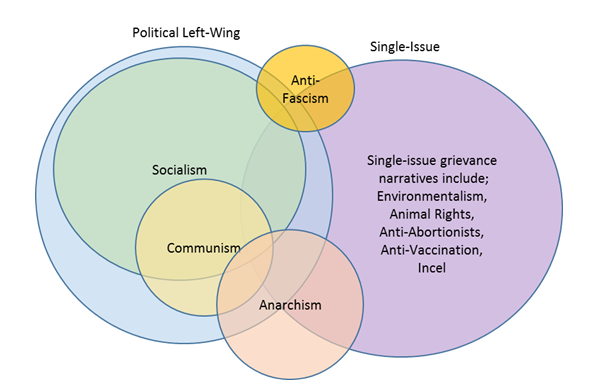
In order to meet the terrorism threshold as defined in the Terrorism Act (TACT 2000), violence must be intended or used to influence the government or intimidate the public in support of an ideology. Therefore, much of LASI activity falls below the terrorism threshold.
What LASIT attacks have taken place in the West?
There has been a history of terrorist violence by left wing, anarchist and single-issue groups in the West. In the 1970s and 1980s groups such as the Red Army Faction (RAF) in Germany, the Red Brigades in Italy and Action Directe in France carried out a wave of attacks across Western Europe. By the late 1980s and 1990s these groups had disbanded following the demise of communist regimes in Europe, however violence by those inspired by left-wing and anarchist ideology has not completely disappeared.
Because of the various definitions of terrorism used by countries in the West, it is difficult to obtain reliable and comparable data on attacks motivated by LASI ideology. According to Europol, there were 24 left-wing or anarchist terrorist attacks in the European Union in 2020, yet only one in 2021. Meanwhile, the proportion of terrorist attacks and plots in the United States motivated by LASI ideology has been steadily falling over the last two decades. However, the rise of extreme right-wing terrorism has seen a corresponding increase in violent activity by anti-fascism (Antifa) groups opposed to it.
Targets of left-wing and anarchist terrorists in the West tend to be political opponents, perceived representatives of the state (notably the police and the judiciary) and major businesses. In many cases, less sophisticated methodologies such as letter and parcel bombs or arson are employed. Historically, LASIT attacks in the West have generally been less lethal than those motivated by extreme right-wing terrorist or Islamist extremist ideology. However, with little LASIT activity in the UK it is difficult to assess how this will manifest in the future.
How does LASIT manifest in the UK?
The threat from terrorism in the UK motivated by LASIT ideology is low. To date, there have been no completed LASIT attacks in the UK.
However, there have been two relatively recent disrupted LASIT plots, both of which fall into the Single-Issue category.
-
In 2019, a 22-year old man was arrested in possession of crossbow and bolts, a machete and body armour. He was subsequently found guilty of possessing articles for the purposes of terrorism under section 57 of the Terrorism Act but was cleared of another charge alleging he wanted to carry out a "spree killing". A jury at the High Court in Edinburgh found the charge that he was motivated by involuntary celibate ideology was not proven.
-
In 2021, a 38-year old man appeared at Crown Court charged with preparing terrorist acts. He was alleged to have carried out reconnaissance of potential targets, purchased equipment and tools, dug hideouts, and sought to recruit others. The plot would have targeted transmitter masts in the Midlands. He is due to stand trial in 2022.
There are currently no left-wing, anarchist or single-issue proscribed organisations in the UK and the majority of LASI activity continues to fall below the terrorism threshold. Whilst some LASI protest activity (including counter protests towards extreme right wing activity) has historically had a violent element, the majority of LASI activity falls into the category of lawful activism. Single-issue grievance narratives that commonly feature within the protest space include environmentalism, animal-rights, anti-abortionists, anti-vaccination and Involuntary Celibacy (see below).
LASI activists in the UK mobilise to undertake terrorist violence very rarely. Therefore, we assess that a terrorist attack in the UK motivated by LASIT ideology to be highly unlikely.
Where does ‘Incel’ fit in?
Involuntary Celibacy or ‘Incel’ is a single-issue grievance narrative, although it can feature alongside a range of other grievance narratives.
Incels are a loose-knit online community, predominantly comprised of men who believe they are unable to form sexual or romantic relationships due to perceived genetic inferiority, social movements such as feminism, and evolutionary traits in female mate selection. Incels harbour frustrations towards women perceived to be attractive and desirable, and men perceived to be genetically superior and sexually active. Essentially, Incels believe they are being denied sexual relationships unjustly through societal norms. They generally consider themselves to be ‘blackpilled’, which denotes a hopeless and fatalist outlook characterised by the inability to ‘ascend’ and have a sexual or romantic relationship.
Most with an Incel mindset are not perpetrators of violence. Incels are more likely to harm themselves rather than the sections of society which are the subject of their frustrations. Criminal acts by Incels are often self-serving rather than to progress an ideology and therefore do not meet the terrorism threshold. Violent acts linked to Incels in North America have targeted educational settings and leisure venues, as opposed to stadiums and event spaces. There have been a small number of violent incidents in the UK, referenced by the media as being undertaken by people aligned to the Incel subculture. Investigations have demonstrated that while the perpetrators may have shown an interest in the subculture, this was not the primary motivating factor.
We currently assess that terrorist threat from Incels is low and that Incel-related activity in the UK remains below the terrorism threshold.
Probability and Likelihood in Intelligence Assessments
When describing threats in intelligence assessments, Counter Terrorism Policing utilises the Probabilistic Yardstick.
The Probabilistic Yardstick is a tool created by the Professional Head of Intelligence Analysis (PHIA), in the UK government, to standardise the way in which we describe probability in intelligence assessments. For example, if we use the term ‘likely’ what we mean is ‘a 55-75% chance’.
Use the scale below as a reference when reading ProtectUK Insights.

Education against Hate - Let’s Discuss: Extreme Left-Wing, Anarchist and Single-Issue Extremism
https://www.educateagainsthate.com/resources/lets-discuss-lasi-extremism/
How can this resource help?
Subject area:
Debate and discussion, Extremism, Let's Discuss, Radicalisation, Terrorism
Age group:
KS 3, KS 4
Resources:
Lesson ideas, Teacher guidance
Format:
Pdf, Presentation slides, Videos

Our ‘Let’s Discuss‘ resources are designed to help teachers facilitate difficult classroom conversations in secondary schools. This resource pack can help you discuss extreme left-wing, anarchist and single-issue extremism with your students.
Knowing how to explain complex topics such as extremism and terrorism can be daunting for teachers. The resource pack contains teacher guidance, a short video and PowerPoint slides. Teachers can show the full video and pause at key points for discussion, or use the shorter snippets from the YouTube playlist to focus on certain themes.
Separate resources are also available explaining the extreme-right wing, fundamental British values and Islamist extremism.
Teacher guidance
Provides an overview of the resources available along with advice on using them in the class and links to more information.
View guidance
The PowerPoint
A set of slides with suggested discussion questions, which can be used by teachers alongside the film.
Film
A film for teachers to show students that explains extreme left-wing, anarchist and single-issue extremism and the impact it can have on people’s lives.
We are not responsible for external content linked on this site. For full details see here. For any questions or comments about the website or any of its content, please contact us. You can also read our Privacy Policy, Terms and Conditions and Accessibility Statement.
2023 educate.against.hate
Hm Government
https://www.facebook.com/Educate-Against-Hate-880079592113682/
https://twitter.com/EducateAgainst
https://www.youtube.com/channel/UChu2N6XCzeofkq0v5WyfKGg/featured
Teacher guidance
Starting conversations about extreme left-wing, anarchist and single-issue extremism
These materials are designed to help teachers initiate conversations in the classroom about extreme left-wing, anarchist or single-issue extremism.
There is no requirement to explicitly teach about extremism in schools. However, helping students to understand what extremism is and the process of radicalisation is one way to help build resilience to harmful narratives. Teachers can use this resource, or parts of this resource, to start discussions in class.
The video covers:
-
An overview of extreme left-wing, anarchist and single-issue extremism
-
Examples of extreme left-wing groups and causes
-
The risks these groups pose
-
How students can counter these ideologies with respect and tolerance
The classroom task can be used to explore the process of radicalisation and how young people can be drawn in.
The resources are designed to be used flexibly with students in Year 9 and above. However, you know your students best. It is strongly recommended that you review the films and handouts before delivering them to identify whether there are themes that might be upsetting for particular students.
Using the film in class

The film is 4 minutes 29 seconds long.
It’s designed to initiate conversations in the classroom. At several points in the video, a ‘pause’ icon appears in the top right corner indicating that it can be paused to open a class discussion.
Alternatively, the film is available as five separate videos.
An editable PowerPoint slide accompanies the video(s) with suggested discussion questions for the class:
-
What does extremism look like?
-
What are some examples of extreme left-wing, anarchist or single-issue extremism?
-
Why are some groups considered extremist and not others?
-
What is radicalisation?
-
What would you do if you were worried about a friend?
-
How would you counter these ideologies with respect and tolerance?
-
How did the video make you feel?
-
What did you learn?
Using the classroom handout
This handout shows the journey of a young person being radicalised into animal rights extremism via social media. It aims to help initiate discussions about the techniques used by extremist groups to get more people to believe their hateful ideas.
For example, students could be asked to:
-
Identify the differences between democratic protest and extremism
-
Identify the differences between terrorism and extremism
-
Identify techniques being used to persuade the main character
-
Consider what they would do if they were in the position of the main character or one of his friends
-
Consider how they would counter ideologies with respect and tolerance
-
Act out the narrative and then develop additional scenes.
Some of the techniques and examples that can be identified in this fictional case-study include:
-
Offering a sense of community and a support network (while creating distance from friends, family and democratic forms of protest)
-
Giving a sense that the individual is ‘special’, building on existing vulnerabilities such as lack of belonging or low self-esteem.
-
Promoting an ‘us and them’ mentality
-
Capitalising on individual grievances and blaming specific communities
-
Encouraging using hatred and violent actions to seek justice
An annotated ‘teacher copy’ is available that highlights how these techniques are demonstrated in the case study.
Definitions
Extremism: The vocal or active opposition to our fundamental values, including democracy, the rule of law, individual liberty, and respect and tolerance for different faiths and beliefs[1].
Terrorism: An action or threat designed to influence the government or intimidate the public. Its purpose is to advance a political, religious or ideological cause.
Radicalisation: Commonly used to describe the processes by which a person adopts extremist views or practices to the point of legitimising the use of violence.
Extreme left-wing: Extremists who believe in using violence and serious criminality to abolish existing systems of Government and replacing them with anarchist, socialist or communist systems.
Capitalism: A economic system based on privately owned businesses and the creation of profit.
Anarchist extremism: Extremists who believe in using violence to replace current systems of Government and law enforcement with a system that prioritises complete liberty and individual freedom.
Single-issue extremism: Extremists who endorse violence and serious criminality focused on a specific topic, such as animal rights.
Democracy: A system of government where people elect their leaders and have a say in how their country is run. Citizens can take part in the democratic process through means such as voting, petitioning and peaceful protest.
Ideology: A collection of ideas or beliefs shared by a group of people.
Communism: An ideology which is built around a model in which all means of production are owned by the community as a whole.
Examples of extreme left-wing, anarchist and single-issue terrorism
The following events are mentioned in the film:
Far-left extremism – Baader-Meinhof
This extreme Far left group, which was also known as the Red Army Faction, wanted to bring a form of communism to Germany. Between 1970 and 1998, they engaged in a series of anarchist extremism, bombings, assassinations, and kidnappings in Germany destroying many people’s lives and livelihoods, and killing more than 30 people.
Anarchist extremism
In Italy in 2016, anarchist groups targeted migration services, with five bombs sent between February and September to travel agencies and related companies. Thankfully, nobody was injured in these incidents.
Single issue extremism – animal rights extremism
Some animal rights activists have bombed buildings and tried to kill people. In the UK in 1999, an extremist animal rights activist planted a homemade bomb on the doorstep of a businessman linked to Huntingdon Life Sciences, a large animal-testing laboratory.
A timeline of terrorism between 1972 and 2018 is available on the SINCE 9/11 website. It includes extreme right-wing and Islamist examples. It is suitable to be used by secondary school students.
Where to find out more information
Vulnerability to radicalisation: Some individuals are more vulnerable to radicalisation than others. More information is available in the Q&A section of Educate Against Hate.
Advice on holding difficult conversations: The Institute for Global Dialogue has produced advice for teachers on holding discussions on difficult topics. This includes tips for facilitating discussion (Chapter 5).
Talking to students after a terrorist attack: The PSHE association have produced a framework for young people to discuss terrorist events, providing opportunities to process what has happened in the safety of a classroom.
Proscribed groups: A list of proscribed (banned) terrorist groups in the UK is available on GOV.UK.
Nazis and the holocaust: The Holocaust Educational Trust aims to educate young people of every background about the Holocaust and the important lessons to be learned for today.
Immigration: A Parliamentary briefing pack on immigration statistics.
Fundamental British Values: A film and handout by Educate Against Hate to facilitate discussions about Fundamental British Values is available here.
The PowerPoint
A set of slides with suggested discussion questions, which can be used by teachers alongside the film.
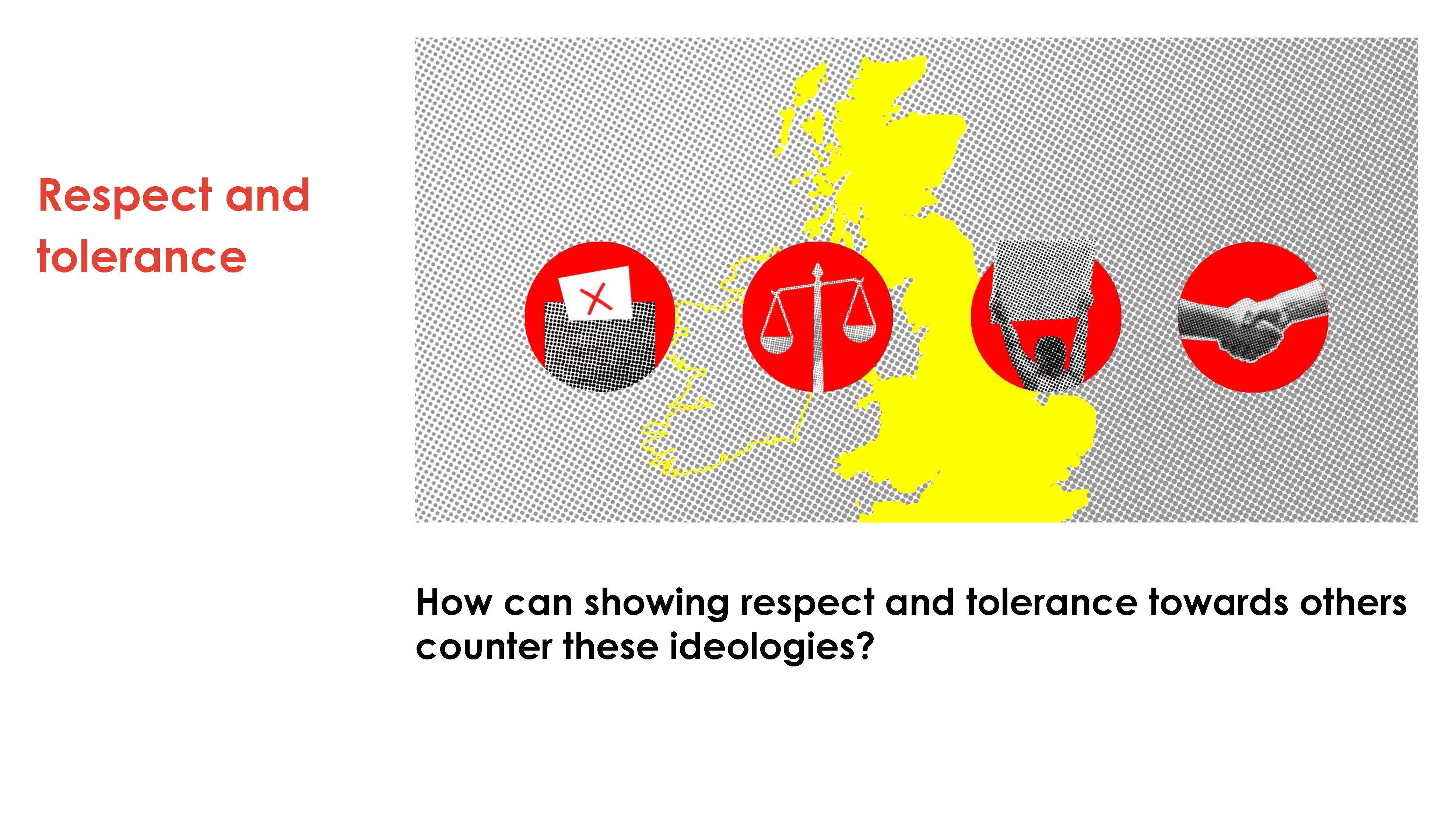
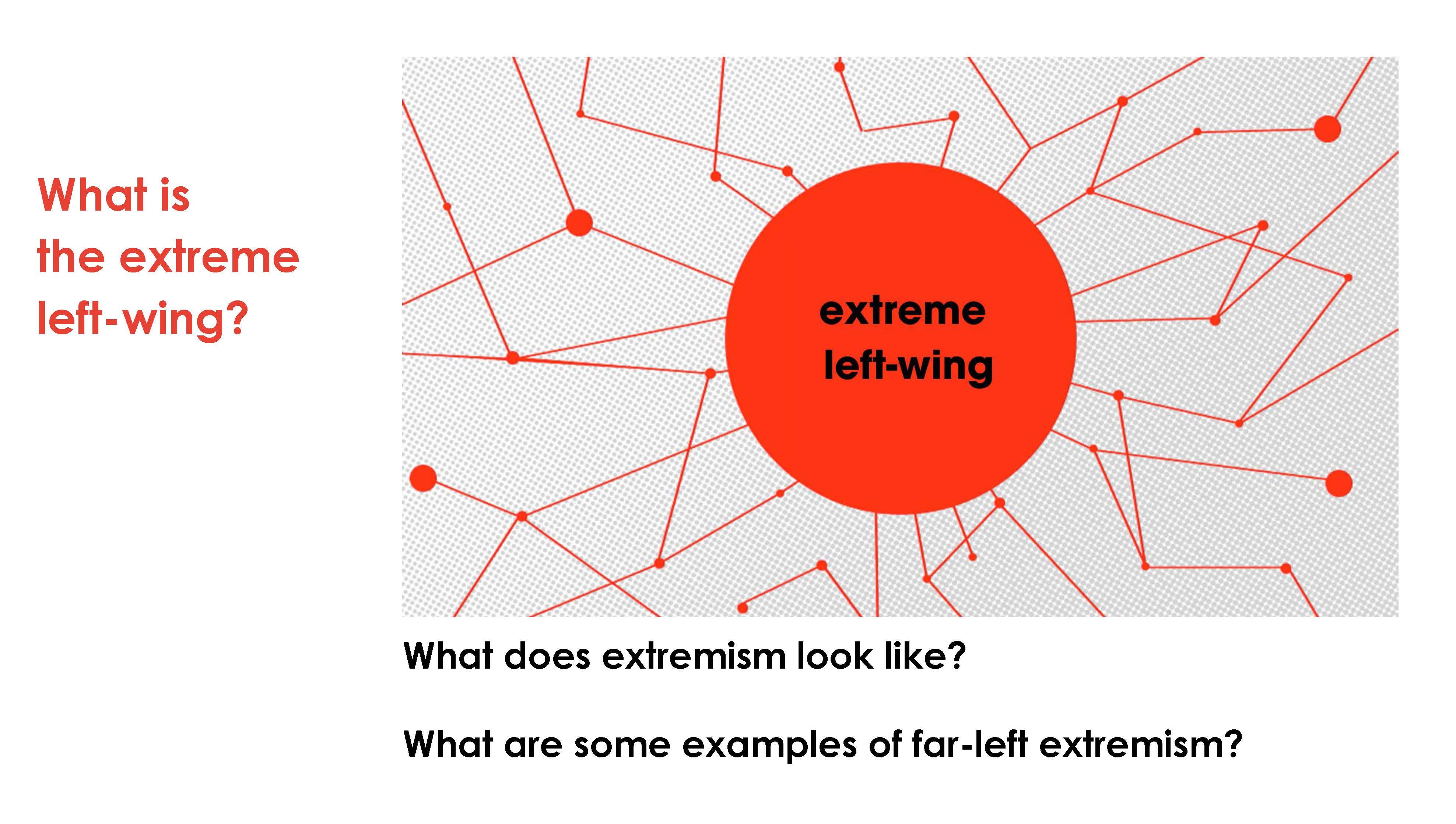

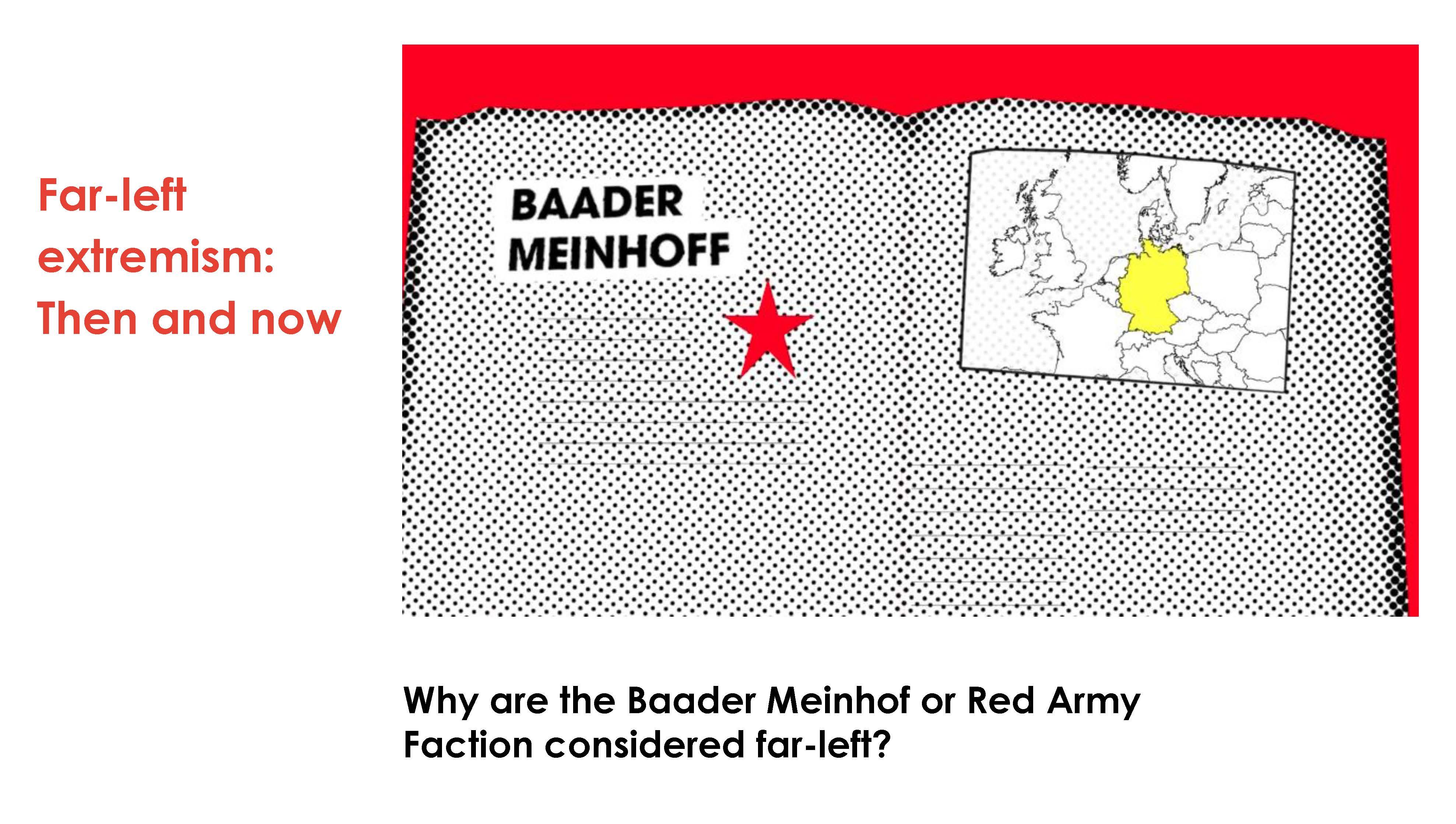
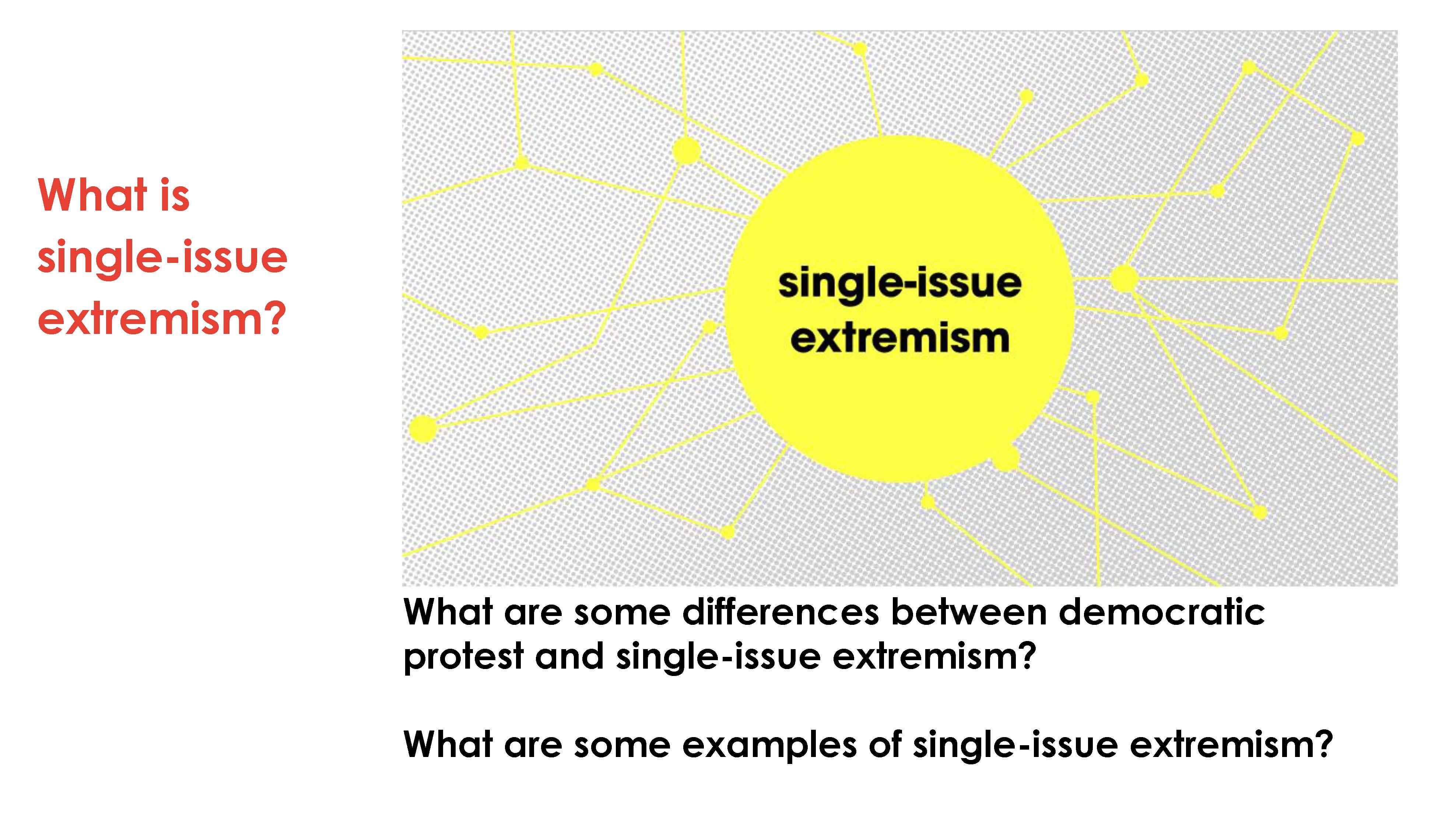
The Film
A film for teachers to show students that explains extreme left-wing, anarchist and single-issue extremism and the impact it can have on people’s lives.
Let's Discuss: Extreme Left-Wing, Anarchist and Single-Issue Extremism
134 subscribers
10 thumbs up
2,587 views
May 6, 2022
This video designed to facilitate conversations in secondary schools about extreme left-wing, anarchist and single-issue extremism. Knowing how to explain complex topics such as extremism and terrorism can be daunting for teachers.
Comments turned off
What is far-left extremism?
Extremism is the word we use to describe active opposition to our society's values.
Extremists encourage division and the hatred of others they wish to cause harm to people who they see as different or simply don't agree with their views.
This film will take a look at far left anarchist and single issue extremism. What these are, and the impact they can have on people's lives.
These issues are all very different with different individuals and organisations for each one.
Some wish for the destruction of all governments. This is called anarchy. Others have a single minded focus on a specific topic, such as animal rights.
However different they are. Extremist members of these different groups share one thing in common. They believe violence is an acceptable means of achieving their goals.
The groups we will discuss in this film use serious and violent criminal behavior.
Some of the causes they support may not be negative or even unpopular, such as animal rights. However, it is their use of violence and criminal methods, and most of all, their willingness to do harm to other people that makes them extremists.
We will now look at the different types of far left extremism, anarchist extremism and the single issue extremism one by one. Let's start with far left extremism.
Far-left extremism: then and now
Far left extremists want to use violence to overturn our democratic system of government and put in a political system that is aligned with their ideology.
Whilst the vast majority of political groups believe in achieving their goals through the democratic process, there are a small number that would deliberately seek out violent confrontations with people who they see as in opposition to their political or social beliefs. They believe that the democratic process is unwilling or unable to achieve their goals, so seek to use their own. force to tackle this issue.
One of the most well known examples of a political extremist organization was the Barda-Meinhoff faction. This extreme far left group, which was also known as the Red Army Faction, wanted to bring a form of communism to Germany between 1970 and 1998. They engaged in a series of bombings assassinations. And kidnappings in Germany destroying many people's lives and livelihoods and killing more than 30 people.
Now let's discuss anarchist extremism.
What is anarchism?
Anarchism is a political ideology which, in its simplest form, believes in removing government and laws. This extremist movement has existed across Europe for many decades.
Currently there is not a high profile active extremist anarchist movement in the UK. However, the ideology and the teachings of anarchists may have inspired or guided other extremists into action.
In Italy in 2016, anarchist groups targeted migration services, with five bombs sent between February and September to travel agencies and related companies. Thankfully, nobody was injured in these incidents.
The final part of this short film will discuss single issue Extremism.
What is single-issue extremism?
We are going to look at the example of animal rights extremism. Almost all animal rights groups are peaceful. However, a small minority are extremists that endorse violence and criminality in what they see as animal liberation.
This could be attacking and even murdering people who work with animals at abattoirs, the place where animals are slaughtered. Or scientists who use animals to learn more about diseases and medicine. Some animal rights activists have bombed buildings and tried to kill people.
In the UK in 1999, an extremist animal rights activist planted a homemade bomb on the doorstep of a businessman linked to Huntingdon life sciences, a large animal testing laboratory.
What is the answer to single-issue extremism?
Thankfully, instances of far left anarchist and single issue extremism in the UK are rare.
It doesn't matter what you believe, left wing or right wing, if you're willing to harm other people for what you believe in, that's extremism.
We have strong laws to prevent violent extremism because violence, killing and criminality will never be the answer.
Across Britain, people engage with political and social issues in a peaceful and respectful way.
People make real change using the democratic process.
[1] The Counter Extremism Strategy 2015
